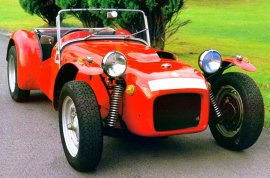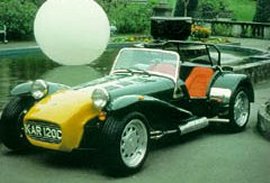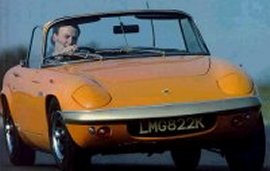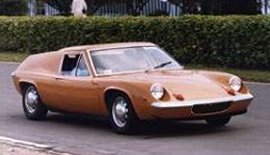Lotus
|
1952 - present |
Country: |
 |
|
Colin Chapman, Engineering Genius
Compared with the other motoring icons
listed in the “Heritage” pages of the
Unique Cars and Parts web site, the story of Lotus is a comparatively
recent one, and owes its existence more than any other
to one man.
The late
Colin Chapman was one of the greatest
innovators of motorcar design, beginning his career
by designing and building specials based on the ubiquitous
Austin Seven. His motoring prowess would see him eventually
rise to control a Grand-Prix racing team, among many
other accomplishments.
The first 'Lotus' car was in the English winter of
1947 - 1948, while Chapman was still studying for his
engineering degree at London University. He continued
to construct other “trial” specials for
competition work, all built to comply with the regulations
of the 750 Motor Club.
These cars were extremely successful,
and Chapman was approached by other enthusiasts to construct
similar vehicles for them. It seemed his hobby had the
makings of becoming a successful business, and so, with
the aid of £25 loaned to him by his girl friend
Hazel (whom he later married), Chapman set about taking
orders and constructing cars for his new clients.
Lotus Enter Production
The first 'production' Lotus was the Mark 6, the first
of many similarly styled cars featuring a multi-tube
space frame chassis enclosing both the engine and transmission,
and incorporating soft independent front suspension
– all adding up to an extremely light weight.
And it was in regards to weight that Chapman became
a devotee, adopting the philosophy that “no item
should be in any way superfluous, or over-strong, for
this simply added unnecessary weight to the machine”.
This philosophy is still very much at the core of production
principles applied to modern day Lotuses.
This basic frame was clothed by stressed aluminium body
panels, and the assembly weighed just 90lb! At first
all Lotuses were 'kit' cars, necessitating that the
customer complete assembly works on their own. And,
like so many English cars, the Mk 6 used many parts
sourced from other manufacturers, in this case Ford
supplying the back axle and cable-operated Girling brakes,
while the Consul derived 1.5 litre engine underwent
modification at the factory to ensure a more sporting
tune.
Lotus Switch From Ford To MG Engines
But soon the Consul engine was replaced by the MG TD
and TF engines, these variants providing the extra power
output required to ensure circuit success for the Lotus.
By the time 1955 rolled around, some 100 Mk. 6’s
had been build, many proving to be highly successful
and competent race cars. It was somewhat fortuitist that Mike Costin was working
for Chapman at the time. When Costin informed Chapman
that his brother Frank was an
aerodynamicist he was
very quickly seconded into working for Lotus and helping
Chapman develop and refine a series of
aerodynamically-efficient
two-seaters with all-enveloping
bodywork – in
an attempt to elicit even better top end performance.
After the 8 and the 9, the Lotus 11 was launched in
1956. There were three versions; the best of the three
dubbed the “Le Mans” and was equipped with
de Dion rear suspension, disc
brakes and a Coventry-Climax
overhead-cam engine of 1.1 or 1.5 litres. Next came
the “Club”, fitted with the same engine
but using a live rear axle and drum brakes; the third
derivative was the utilitarian “Sports”,
similar to the Club but fitted with a feeble side-valve
1172cc Ford engine.
Like previous Lotuses, the 11 had a multi-tube space
frame chassis, now with the floor and transmission tunnel
panels acting as structural members to add to overall
chassis stiffness. The full-width style was distinguished
by the use of a fairing placed behind the driver's head. And as could be expected from any car to emerge from
the Lotus stable, the 11 proved a very successful race
car. They would go on to dominate their class, and never
more so than at the 1957 Le Mans where French built
cars had traditionally dominated.

The first production Lotus was the Mark. 6,
using a multi-tube space frame chassis...

The Lotus 11 would take out the 1957 Le Mans
"Index of Performance"...

The Elite's reputation was tarnished by build
quality problems, although most would blame
the "home-mechanics" responsible for
final assembly...

The Seven could be purchased with, or without,
engine and driveline...

The Elan shared engines with the Lotus Cortina...

The Europa used the Renault 16's engine and
transmission, although Lotus engineers had to
modify it for mid engine installation...

The wedge shaped 1974 Elite was beautifully
designed...

The turbo Esprit could top 150mph...
|
The Coventry-Climax Help Lotus Take Out The Index Of Performance
Their category in
that race was the “Index of Performance”,
and with a specially built 750cc Coventry-Climax engine
in one car, the Lotuses took first and second in the
Index, won the 1100cc class, and finished ninth 13th,
14th and 16th overall. A total of 150 Mk. II’s
were built, 64 being shipped to the US where some resourceful
owners even adapted them for road use!
1957 was also important in that the Mark 6 was phased
out, and the Seven launched. Different in many respects
over its predecessor, the Seven used smaller diameter
tubing in the chassis construction and featured a coil
spring independent front suspension borrowed from the
Formua 2 Lotus single-seater.
It also had a live rear
axle, suspended by combined coil spring/damper units,
and located to the chassis by twin trailing arms and
a diagonal member. For the first time a Lotus had
brakes on all four wheels, although they were still only drums,
and was powered courtesy of a Ford 100E side-valve 1172cc
engine mated to a three-speed gearbox.
The shape of the Seven was very much like that of the
6, with square rig lines, and separate front wings,
but the nose tapered a little more, and there was improved
storage space located behind the seats. And, naturally,
the little Lotus weighed in at featherweight 725lb.
The Super Seven was soon to follow, fitted with the
Coventry-Climax 1100cc engine and wire spoke wheels.
This was again followed by the Series 2 version in 1960,
the chassis frame layout being simplified and the existing
15in wheels being replaced by smaller 13in wheels.
As
always weight was kept to a minimum, the nose cone and
front wings being made of fibre-glass, and back axle
location by an A-bracket. The basic car still had a
Ford engine and sold for £587, but there was also
the option of a BMC A-Series unit for £611. To
help improve sales, prices were slashed by a full £100
in 1961 and you could even buy a Seven without the engine
and transmission for a mere £399.
The First Practical Lotus, The Elite
But no doubt of more interest to those visiting the
Unique Cars and Parts web site was the 1957 release
of, arguably, their most important road car –
certainly the vehicle that would pave the way for future
production. Launched at the London Motor Show, the “Elite”
featured stunning looks and, as a two-seater fixed-head
coupe, was technically unique by using a monocoque construction
made entirely from fibreglass.
The Elite's engine was another variation on the Coventry-Climax
theme, being a 75bhp 1216cc unit with a single
SU carburettor (though a twin-carb/85bhp version was also on offer).
The Elite used 4 wheel disc-brakes and independent suspension,
allied to rack and pinion steering, and center-lock
wire wheels; the suspension, in both cases, was derived
from that chosen for the 1957 Lotus F2 single-seater.
The Elite was an enigma. Although it was undeniably
advanced, and a superbly fast car, it suffered from
many detail faults, and unreliability problems. Many
Elites were sold in partly-assembled 'kit form,' to
be finished off by their new owners, and many believed
that it was in the final assembly by “backyard
mechanics” that was exacerbating the problem.
But regardless of the problems being encountered, when
an Elite was assembled properly it was like no other
car in its ability to hold the road and communicate
with the driver. Many forgave the Elites seemingly slow
performance (good for a top speed of 104mph, and 0-60mph
acceleration of around 10 seconds) when considering
the small engine capacity. Like the Lotuses before it,
the Elite would enjoy race track success.
The Elite Beats 16 Alfa's At The Nurburgring
At the
Nurburgring an Elite would beat sixteen Alfa Romeos to win the 1300cc
GT class, while at Le Mans an Elite would win the 1500cc
class, and finished eighth overall!
In 1962 the Elan would take over from the Elite. Once
again an entirely different type of chassis would be
used, but for the Elan the chassis would be designed
specifically to enable ease of repair. Chapman believed
in the advantages of a separate chassis, especially
for convertibles, and so the brief was develop a rigid
folded steel backbone frame – a design that would
remain for many years in subsequent models. The Elan
used a Ford twin-cam 1499cc engine, but under the direction
of Harry Mundy that was soon increased to 1558cc –
a sweet and powerful engine that would also be used
on the
Lotus Cortina.
Naturally the Elan retained the Elites 4 wheel disc
brake setup, although a contentious point was in the
rear discs configuration; fitted “outboard”
and used in conjunction with rubber drive shaft “doughnuts”
the Elan gained a reputation for transmission wind-up,
and the “doughnuts” always had a limited
lifespan. The body was again made of fibreglass, but
instead of incorporating numerous mouldings as was done
for the Elite the Elan instead used only 2 large mouldings.
The Lotuses were quickly gaining a large supporter
base, due mainly to the spirited driving provided by
such a sweet chassis set up, light weight and extremely
responsive steering. In 1964 an improved Series S2 Elan
was announced, and a year later the more civilized fixed-head
coupe also joined the range. The S3 drop head soon followed,
that was overtaken by the yet more civilized S4 model
and in 1970 the Elan Sprint, with the “big valve”
126bhp engine was released.
The Introduction Of The Elan +2
British car manufacturers had long acknowledged the
practicality of providing customers with a 2+2 seater
configuration, and so the Elan + 2 was a natural evolution
of the car. The +2 basically used the Elan-style chassis,
but had its wheelbase extended by 12 inches, used a
wider track and afforded a roomier interior. The car
was only offered in fixed-head coupe form, though a
few private-venture convertibles were made in later
years. The Plus 2S which followed was more luxurious
than the original, while the final manifestation was
the Plus 2S 130 which had a 126bhp engine and optional
5-speed gearbox.
In 1966 the Europa was released, designed to bring a
more simple low cost sports car to the European market.
The Europa was fitted with a Renault 16 engine and transmission,
although Lotus engineers re-designed many key areas
to enable the otherwise front drive/front engine design
to suit the mid-engine configuration. Using a similar
backbone chassis as was on the Elan, the Europa featured
supple independent suspension and superb road-holding
– now a hallmark of anything carrying the Lotus
badge.
Improvements came in 1969 with the release of the S2,
and perhaps the best of the Europa’s appeared
in 1971 when a 105bhp Lotus twin-cam engine was fitted,
not surprisingly dubbed the “Europa TwinCam”.
Just a year later the Twin-Cam gave way to the Europa
Special, which had the big-valve 126bhp engine and a
five-speed gearbox; now making the Europa good for a
top speed in excess of 120mph and capable of the 0-60mph
dash in under 7 seconds.this gave it a maximum speed
of more than 120mph, and 0-60mph acceleration in 6.6
seconds. Production finally ceased in 1975, after 9230
cars had been manufactured.
The New Generation Elite And Mid-Engined Esprit
The new generation mid 1970’s Lotuses included
a new generation Elite and mid-engined Esprit. These
cars were much larger, heavier, and more sophisticated
than their predecessors, and many believed they were
somewhat compromised in an attempt to make them more
appealing to a broader customer base. But at
Unique Cars and Parts we consider the Lotus to be the least
of the great marques to have compromised its core sports
car principles, and such criticism is ill founded.
No longer was a Lotus available in kit form –
the construction now far too technically advanced. Rather,
the key to the new Lotuses success lay in the brand
new 16-valve four-cylinder 2-litre twin-camshaft engine,
which remained as the company's mainstay until the mid-
1980s. And the lack of kit-form enabled the new cars
to make great strides in terms of safety, styling and
fuel efficiency (and of course a little comfort).
Of the front-engined cars, the Elite was a close-coupled
four-seater with a hatchback cabin, but a wedge-nose
style, while the Eclat which followed it was a conventional
2+2 coupe on the same chassis. The Esprit, however,
was a much more striking mid-engined two-seater coupe,
based on a “Giugiaro” styling exercise that
was first seen on the basis of a “Europa”
chassis in 1972; the Esprit was arguably the prettiest
of the entire range of wedge styled Lotuses.
The Esprit would go on sale in 1976, again using a steel
backbone chassis with all-independent suspension and
four-wheel disc brakes. The engine was placed behind
the seats, and drove through a modified Citroen five-speed
transaxle. The body, of course, was a fibreglass composite
shell. The result was an extremely quick car both in
a straight line and around corners, however unfortunately
as was the case with so many previous Lotuses there
it was lacking in detail development and reliability
– and this time the “home-mechanic”
could not be blamed.
The Esprit Turbo, The First Lotus Super Car
Fortunately the S2 and later S3 models went a long
way to addressing the problems inherent in the original
Esprit, although if considering the purchase of an original
it would be safe to assume that any such problems with
the car should have been well and truly sorted. The
next addition to the range, the Lotus Esprit Turbo,
took the company straight into the “Super-car”
league; the Turbo’s 2.2 litre engine was obviously
turbocharged, and was good for 210bhp. Lotus engineers
also re-tuned the chassis frame, and there was comprehensive
re-style to complement the cars amazing performance.
Lotus quoted a top speed of just more than 150mph for
the Esprit Turbo, together with the ability to reach
60mph from rest in 5.5 seconds. This sort of performance,
linked to the usual matchless road-holding standards
and surprisingly frugal fuel consumption, enabled the
Esprit Turbo to stand comparison with any other exotic
machine.
Also see: Lotus Car Reviews |
Colin Chapman |
The History of Lotus (USA Edition) 


